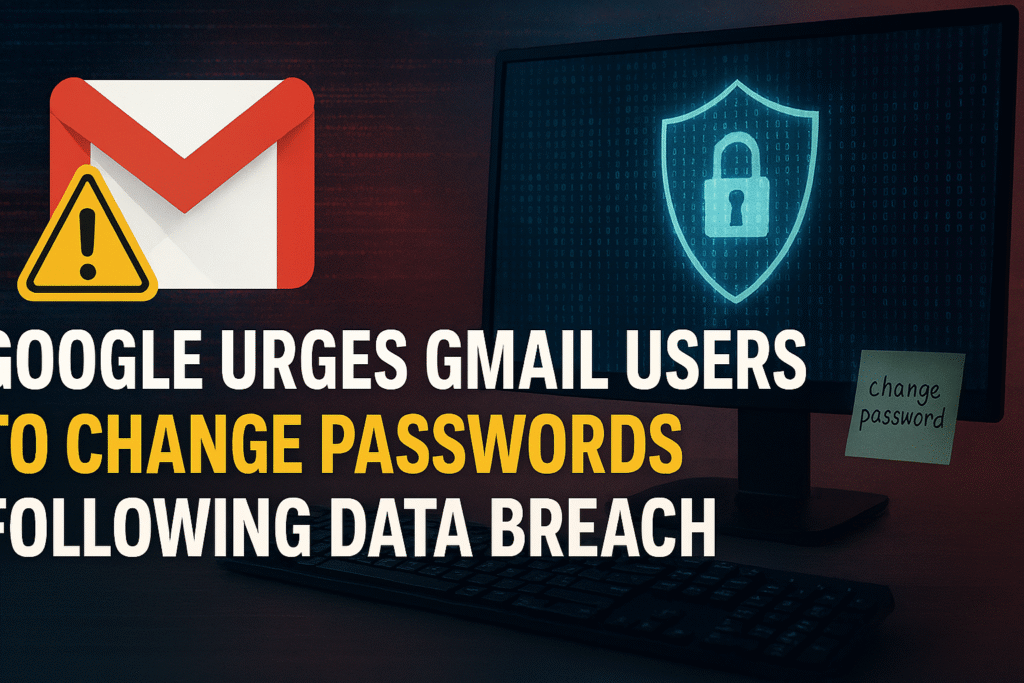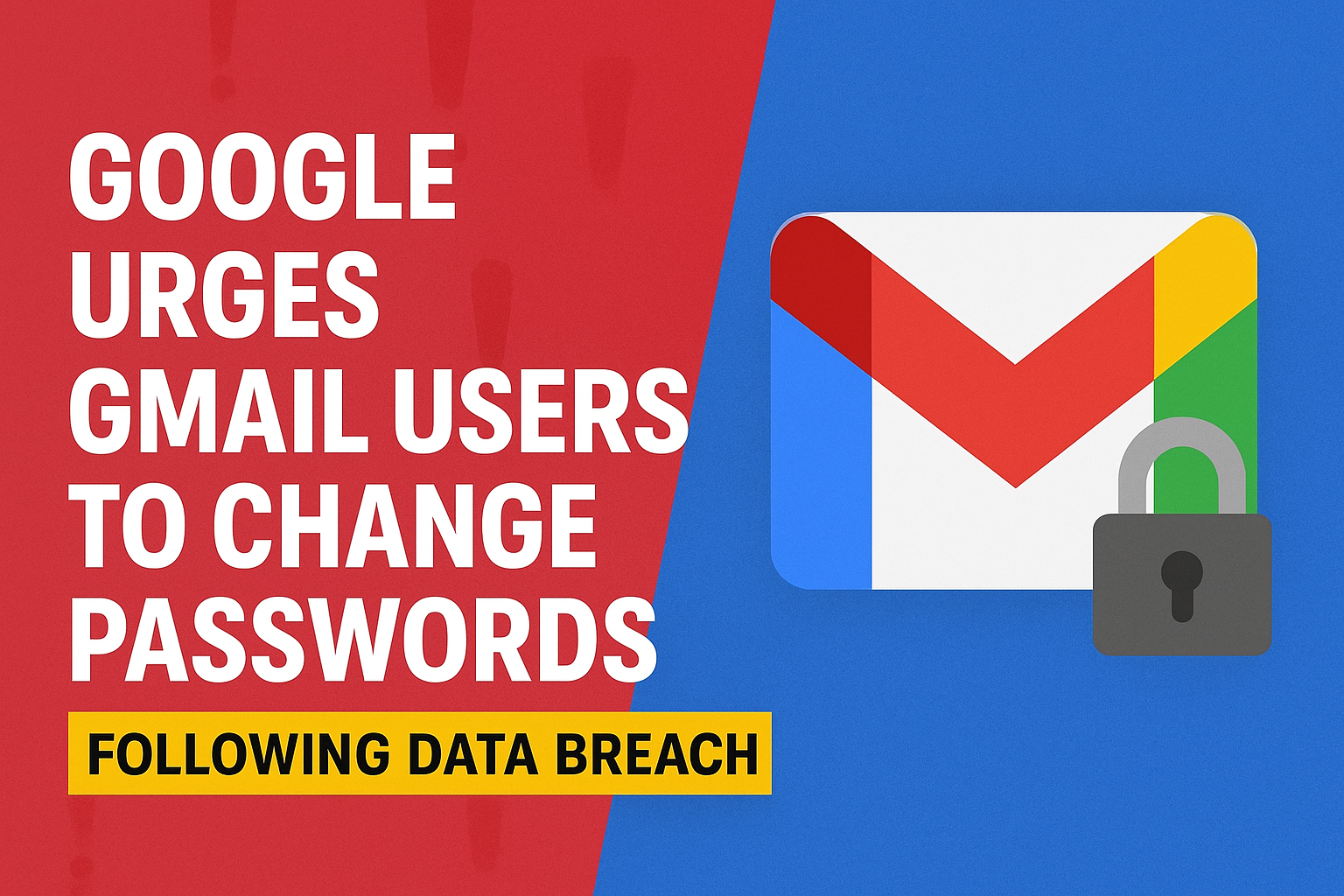Google Urges Gmail Users to Change Passwords following a major security alert that affects over 2.5 billion users worldwide. This unprecedented warning comes after a data breach involving a third-party Salesforce system, which exposed business contact information used by Google’s enterprise clients.
Although Gmail account passwords themselves were not directly compromised, the exposed data could be leveraged by cybercriminals to craft highly convincing phishing and vishing attacks, putting everyday users at risk.
By issuing this alert, Google emphasizes the importance of proactive account security, urging users to review and strengthen their account credentials. This step is essential to prevent unauthorized access and safeguard sensitive personal and professional information.
Understanding the Data Breach
The recent security alert that Google Urges Gmail Users to Change Passwords stems from a breach orchestrated by the notorious ShinyHunters hacking group, known for targeting large-scale corporate databases. In this incident, the group gained access to a third-party Salesforce system, which contained sensitive business contact information from various organizations.
It’s important to note that no Gmail account passwords were compromised during this breach. User login credentials remained secure; however, the exposed data includes emails, phone numbers, and professional details of individuals, which cybercriminals can exploit.
This type of information can be used for phishing emails that appear legitimate, or vishing (voice phishing) calls that manipulate victims into revealing confidential details. For instance, an attacker could pose as a company executive and request sensitive data or convince users to click on malicious links. Such attacks highlight why Google emphasizes proactive security measures and why Google Urges Gmail Users to Change Passwords as a precautionary step—even though passwords themselves weren’t leaked.
Also Read: Report: Company Denies Rumours of TikTok’s Return to India
Why Google Is Advising Gmail Password Changes

In recent weeks, cybersecurity reports indicate a sharp rise in phishing attempts targeting Gmail users. Cybercriminals are leveraging the leaked business contact information to craft convincing scams, making it easier to trick even tech-savvy users. This surge in attacks is a key reason why Google Urges Gmail Users to Change Passwords immediately, as a preventative measure.
Changing your password is one of the simplest yet most effective ways to prevent unauthorized access to your account. Even if your credentials were not part of the breach, using a strong, unique password ensures that attackers cannot exploit any indirect information gained from the exposed data. Statistics show that accounts with compromised credentials that weren’t updated promptly are 70% more likely to be targeted in subsequent phishing campaigns.
Google also recommends enhancing overall account security by enabling two-factor authentication (2FA), reviewing connected apps, and performing regular Google Security Checkups. These measures, combined with updating passwords, create multiple layers of protection against both phishing and potential account takeovers. By following these steps, users can significantly reduce their risk while maintaining control over their Gmail accounts.
Also Read: Microsoft’s New Copilot 3D—AI Tool Converts Images to 3D Models Instantly
Step-by-Step Guide: How to Change Your Gmail Password
To ensure your Gmail account remains secure, Google Urges Gmail Users to Change Passwords immediately following the recent data breach. Here’s a clear guide on how to update your password on different devices:
1. Desktop Browser
- Open Gmail and click on your profile icon in the top-right corner.
- Select Manage your Google Account → Security → Password.
- Enter your current password, then create a new, strong password.
- Click Change Password to save the update.
2. Android Devices
- Open the Gmail app, tap your profile picture, then go to Manage your Google Account.
- Navigate to Security → Password, enter your current password, and set a new one.
- Confirm and save changes.
3. iOS Devices (iPhone/iPad)
- Open the Gmail app, tap your profile, then Manage your Google Account → Security → Password.
- Enter your existing password, choose a new one, and confirm.
Tips for Creating Strong, Unique Passwords
- Use a mix of uppercase, lowercase, numbers, and symbols.
- Avoid common words or easily guessed patterns.
- Consider using a password manager to generate and store complex passwords.
- Never reuse passwords across multiple accounts.
By following these steps, you ensure your Gmail account is better protected, reducing the risk of unauthorized access. Remember, Google Urges Gmail Users to Change Passwords not only as a precaution but as a key step in keeping your personal and professional information safe.
Enhancing Security Beyond Password Changes
While updating your password is crucial, Google Urges Gmail Users to Change Passwords as part of a broader strategy to enhance account security. To stay ahead of cyber threats, additional protective measures are essential.
1. Enable Two-Factor Authentication (2FA)
Two-factor authentication adds an extra layer of security by requiring a second verification step, such as a text message, authentication app code, or security key. Research shows that accounts with 2FA enabled are 99.9% less likely to be compromised. Activating 2FA ensures that even if a password is stolen, attackers cannot access your account without the second factor.
2. Consider Passkeys
Passkeys are a modern, more secure alternative to traditional passwords. They use cryptographic keys stored on your device, making phishing attacks nearly impossible. As Google continues to expand passkey support, adopting them can significantly reduce the risk of unauthorized access while simplifying login.
3. Use Google’s Security Checkup Tool
Google’s Security Checkup tool provides a personalized assessment of your account. It highlights connected devices, recent security events, and third-party app access, offering actionable steps to strengthen your account. Regularly reviewing this tool helps you detect and respond to potential vulnerabilities promptly.
By combining password updates with these additional measures, users follow Google’s recommendations and significantly improve their Gmail security posture. The alert that Google Urges Gmail Users to Change Passwords is only the first step in a comprehensive approach to protecting your digital information.
Recognizing and Avoiding Phishing and Vishing Attacks
In light of recent security concerns, Google Urges Gmail Users to Change Passwords to reduce the risk of unauthorized access. However, staying safe also requires awareness of phishing and vishing threats that exploit exposed data.
1. Common Signs of Phishing Emails and Vishing Calls
- Emails or messages urging immediate action, such as “Update your password now” or “Verify your account.”
- Suspicious links that don’t match the official Gmail or Google domains.
- Unexpected calls from individuals claiming to be Google support, often requesting confidential information.
- Generic greetings, grammatical errors, or messages that create a sense of urgency.
2. How to Verify Suspicious Communications
- Hover over links to check URLs before clicking.
- Contact the company directly using official contact information rather than responding to the message.
- Avoid downloading attachments from unknown senders.
- Use Gmail’s built-in reporting tools to flag phishing attempts.
3. Google’s Security Reminders
Google will never ask for your password, verification codes, or personal information via email or phone. Any communication requesting such details should be treated as suspicious and reported immediately.
By learning to identify and avoid these scams, users complement the precaution of changing passwords. Following these practices ensures that the warning Google Urges Gmail Users to Change Passwords is not just a formality, but part of a proactive approach to digital security.
What to Do If You Suspect Your Account Has Been Compromised
Even after following precautions, situations may arise where your Gmail account shows signs of unauthorized activity. In such cases, Google Urges Gmail Users to Change Passwords immediately as a critical first step. Beyond that, taking prompt action can prevent further damage.
1. Immediate Steps if Unauthorized Access is Detected
- Change your Gmail password right away, using a strong, unique combination.
- Review your recent account activity in Gmail to spot unfamiliar logins or devices.
- Sign out of all other devices to prevent continued access from any compromised sessions.
2. Reporting Suspicious Activity to Google
- Use Google’s Security Checkup to review your account and follow suggested actions.
- Report phishing emails or suspicious activity directly through Gmail’s reporting tools.
- Contact Google support if you notice repeated unauthorized attempts or suspicious behavior.
3. Additional Resources for Assistance
- Google provides step-by-step guides and tutorials for securing accounts.
- Utilize online cybersecurity resources to learn about phishing, vishing, and safe online practices.
- Consider using a password manager or security-focused apps to monitor account health continuously.
By combining immediate password updates with these proactive steps, users ensure their accounts remain secure. This is why Google Urges Gmail Users to Change Passwords—even as a preventive measure—to protect personal and professional data from potential threats.
The recent alert from Google highlights the importance of proactive security measures. Google Urges Gmail Users to Change Passwords as an essential step, but true protection goes beyond a single action. Users should combine password updates with two-factor authentication, passkeys, and regular security checkups to safeguard their accounts.
Regular vigilance is key: monitor account activity, be aware of phishing and vishing attempts, and report any suspicious communications. Staying informed about evolving cybersecurity threats ensures that your Gmail account remains secure against potential attacks.
By taking these steps consistently, users not only respond to Google’s warning but also build long-term habits for digital safety. Remember, when it comes to protecting sensitive information, Google Urges Gmail Users to Change Passwords, and your proactive actions make all the difference.




